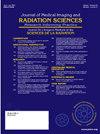Comparative analysis of transformer-based deep learning models for glioma and meningioma classification
IF 2
Q3 RADIOLOGY, NUCLEAR MEDICINE & MEDICAL IMAGING
Journal of Medical Imaging and Radiation Sciences
Pub Date : 2025-06-18
DOI:10.1016/j.jmir.2025.102008
引用次数: 0
Abstract
Introduction/Background
This study compares the classification accuracy of novel transformer-based deep learning models (ViT and BEiT) on brain MRIs of gliomas and meningiomas through a feature-driven approach. Meta’s Segment Anything Model was used for semi-automatic segmentation, therefore proposing a total neural network-based workflow for this classification task.
Methods
ViT and BEiT models were finetuned to a publicly available brain MRI dataset. Gliomas/meningiomas cases (625/507) were used for training and 520 cases (260/260; gliomas/meningiomas) for testing. The extracted deep radiomic features from ViT and BEiT underwent normalization, dimensionality reduction based on the Pearson correlation coefficient (PCC), and feature selection using analysis of variance (ANOVA). A multi-layer perceptron (MLP) with 1 hidden layer, 100 units, rectified linear unit activation, and Adam optimizer was utilized. Hyperparameter tuning was performed via 5-fold cross-validation.
Results
The ViT model achieved the highest AUC on the validation dataset using 7 features, yielding an AUC of 0.985 and accuracy of 0.952. On the independent testing dataset, the model exhibited an AUC of 0.962 and an accuracy of 0.904. The BEiT model yielded an AUC of 0.939 and an accuracy of 0.871 on the testing dataset.
Discussion
This study demonstrates the effectiveness of transformer-based models, especially ViT, for glioma and meningioma classification, achieving high AUC scores and accuracy. However, the study is limited by the use of a single dataset, which may affect generalizability. Future work should focus on expanding datasets and further optimizing models to improve performance and applicability across different institutions.
Conclusion
This study introduces a feature-driven methodology for glioma and meningioma classification, showcasing advancements in the accuracy and model robustness of transformer-based models.
基于转换器的神经胶质瘤和脑膜瘤分类深度学习模型的比较分析
本研究通过特征驱动的方法比较了新型基于变压器的深度学习模型(ViT和BEiT)在脑胶质瘤和脑膜瘤mri上的分类准确率。Meta的Segment Anything Model用于半自动分割,因此为该分类任务提出了一个完全基于神经网络的工作流程。方法利用公开的脑MRI数据集对svit和BEiT模型进行微调。神经胶质瘤/脑膜瘤病例(625/507)用于训练,520例(260/260;胶质瘤/脑膜瘤)进行检测。对ViT和BEiT提取的深部放射学特征进行归一化、基于Pearson相关系数(PCC)的降维和方差分析(ANOVA)的特征选择。采用1个隐藏层、100个单元、整流线性单元激活和Adam优化器的多层感知器(MLP)。通过5倍交叉验证进行超参数调优。结果ViT模型在7个特征的验证数据集上获得了最高的AUC, AUC为0.985,准确率为0.952。在独立测试数据集上,该模型的AUC为0.962,准确率为0.904。BEiT模型在测试数据集上的AUC为0.939,准确率为0.871。本研究证明了基于变压器的模型,特别是ViT,在胶质瘤和脑膜瘤分类中的有效性,获得了很高的AUC评分和准确性。然而,该研究受到单一数据集使用的限制,这可能会影响通用性。未来的工作应侧重于扩展数据集和进一步优化模型,以提高不同机构的性能和适用性。本研究引入了一种特征驱动的神经胶质瘤和脑膜瘤分类方法,展示了基于变压器的模型在准确性和模型鲁棒性方面的进步。
本文章由计算机程序翻译,如有差异,请以英文原文为准。
求助全文
约1分钟内获得全文
求助全文
来源期刊

Journal of Medical Imaging and Radiation Sciences
RADIOLOGY, NUCLEAR MEDICINE & MEDICAL IMAGING-
CiteScore
2.30
自引率
11.10%
发文量
231
审稿时长
53 days
期刊介绍:
Journal of Medical Imaging and Radiation Sciences is the official peer-reviewed journal of the Canadian Association of Medical Radiation Technologists. This journal is published four times a year and is circulated to approximately 11,000 medical radiation technologists, libraries and radiology departments throughout Canada, the United States and overseas. The Journal publishes articles on recent research, new technology and techniques, professional practices, technologists viewpoints as well as relevant book reviews.
 求助内容:
求助内容: 应助结果提醒方式:
应助结果提醒方式:


